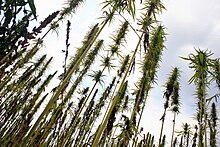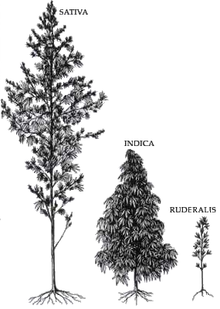Why indeed should Jamaica lose out on the ganja medicine industry?
Friday, January 10, 2014
Print this page Email A Friend!
A ganja plant
News this week out of Uruguay that foreign firms have expressed great interest in opening laboratories there to study the potential medicinal uses of marijuana, now that ganja has been legalised in that country, is quite interesting.
According to an Associated Press report, presidential spokesman Diego Canepa has revealed that foreign labs have told the Government they would like to set up there. "Uruguay will become a hub for biotechnology," Mr Canepa was quoted by the local daily El Observador, even as he admitted that that was not the intention of the law allowing the sale of ganja to registered users.
The newspaper also reported that the Canadian Government has started talks to import marijuana from Uruguay for medicinal purposes.
Other international news sources have also reported that Chile and Israel are interested in buying supplies of the weed from Uruguay.
That, however, may pose a bit of a problem for the Uruguayan Government because the law is silent on the issue of exporting marijuana. But that, we are told, is likely to be addressed by a government commission in a few months' time.
How that will play out with the international community is left to be seen, especially for the fact that many countries observe tough laws relating to marijuana use, sale and possession.
However, we here in Jamaica should pay great attention to this development in Uruguay, especially because of the great interest here in developing an industry to manufacture medical products from ganja.
Just last month, our own renowned scientist Dr Henry Lowe officially opened a company that will extract marijuana's medicinal components for commercial purposes.
Dr Lowe, who has gained worldwide attention for his anti-cancer research, has told us that his company -- Medicanja -- will conduct clinical research to extract the components of marijuana that can cure a variety of illnesses. He also proposes to develop a strain of the plant which is less potent in tetrahydrocannabinol, the component of ganja which provides the 'high' for smokers and the reason that the weed is banned.
According to Dr Lowe, the hemp industry in Canada is valued at US$2 billion annually. That, he insisted, is cause for the Jamaican Government to give serious consideration to developing a medical marijuana industry here.
Add to that the fact that Jamaican scientists have already developed a commercial product from ganja -- Canasol, which is used to treat glaucoma -- and you will understand that what we have here is the potential to make billions of dollars that could ease our economic burden.
Dr Lowe pointed out that very fact at the launch of his company as he appealed to the Government to not let Jamaica lose out on a multi-billion-dollar industry which is booming in Europe, Canada and the United States.
"Why should we sit back and allow other people to take over?" Dr Lowe asked.
That is a most relevant question.
Friday, January 10, 2014
Print this page Email A Friend!
A ganja plant
News this week out of Uruguay that foreign firms have expressed great interest in opening laboratories there to study the potential medicinal uses of marijuana, now that ganja has been legalised in that country, is quite interesting.
According to an Associated Press report, presidential spokesman Diego Canepa has revealed that foreign labs have told the Government they would like to set up there. "Uruguay will become a hub for biotechnology," Mr Canepa was quoted by the local daily El Observador, even as he admitted that that was not the intention of the law allowing the sale of ganja to registered users.
The newspaper also reported that the Canadian Government has started talks to import marijuana from Uruguay for medicinal purposes.
Other international news sources have also reported that Chile and Israel are interested in buying supplies of the weed from Uruguay.
That, however, may pose a bit of a problem for the Uruguayan Government because the law is silent on the issue of exporting marijuana. But that, we are told, is likely to be addressed by a government commission in a few months' time.
How that will play out with the international community is left to be seen, especially for the fact that many countries observe tough laws relating to marijuana use, sale and possession.
However, we here in Jamaica should pay great attention to this development in Uruguay, especially because of the great interest here in developing an industry to manufacture medical products from ganja.
Just last month, our own renowned scientist Dr Henry Lowe officially opened a company that will extract marijuana's medicinal components for commercial purposes.
Dr Lowe, who has gained worldwide attention for his anti-cancer research, has told us that his company -- Medicanja -- will conduct clinical research to extract the components of marijuana that can cure a variety of illnesses. He also proposes to develop a strain of the plant which is less potent in tetrahydrocannabinol, the component of ganja which provides the 'high' for smokers and the reason that the weed is banned.
According to Dr Lowe, the hemp industry in Canada is valued at US$2 billion annually. That, he insisted, is cause for the Jamaican Government to give serious consideration to developing a medical marijuana industry here.
Add to that the fact that Jamaican scientists have already developed a commercial product from ganja -- Canasol, which is used to treat glaucoma -- and you will understand that what we have here is the potential to make billions of dollars that could ease our economic burden.
Dr Lowe pointed out that very fact at the launch of his company as he appealed to the Government to not let Jamaica lose out on a multi-billion-dollar industry which is booming in Europe, Canada and the United States.
"Why should we sit back and allow other people to take over?" Dr Lowe asked.
That is a most relevant question.



































Comment